Table of Contents: Links to related documents:
- In-flight data with HRMA door closed (F. Baganoff, postscript)
- Pre-flight data
The ACIS background consists of a relatively soft Cosmic X-ray Background (CXB) contribution and cosmic ray-induced events with a hard spectrum. Most cosmic ray events can be filtered out by applying a grade filter (e.g., rejecting ASCA grades 1,5,7). After such filtering, the CXB component dominates below ~2 keV (during the quiescent background intervals, see below) and the cosmic ray component dominates above ~5 keV, consistently with the pre-launch estimates.
1. Background flares
A phenomenon not anticipated prior to launch that can seriously affect the scientific value of an observation is background flares, when the count rate can increase by a factor of up to 100. Such flares have been observed anywhere in the orbit, including near the apogee. They are most prominent in the BI chips but also affect the FI chips. The nature of these flares is under investigation (ask S. Virani and P. Plucinsky for an update), but they generally correlate with the increased EPHIN rate for soft electrons. The flares are easily seen in the ACIS light curves; several examples are shown below.
The figure below shows an observation moderately affected by the flares (OBSID 1190). The horizontal axis gives Chandra time; the rates shown are for the BI chip S3 (upper curve) and the FI chip I2 (lower curve), for ASCA grades 02346 and energies below 10 keV. Although celestial sources were not excluded from these light curves, the flux is dominated by the background:
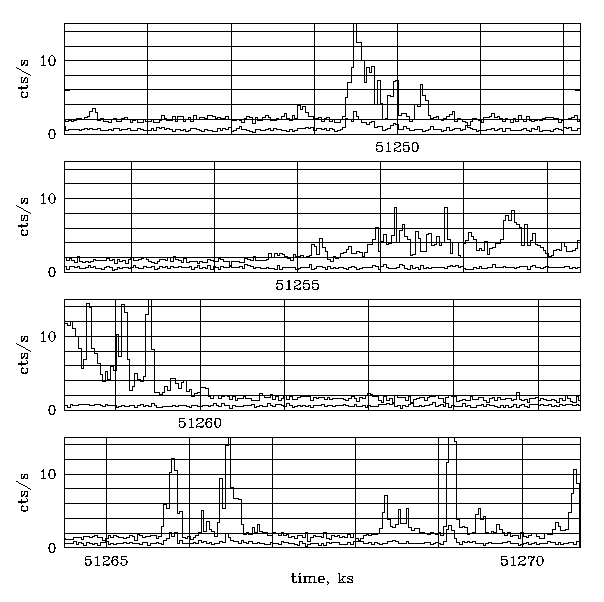 (PS)
(PS)
The rate is constant most of the time but there are several strong flares. Note how chip S3 is affected more strongly by these flares.
Below is an example of an extremely bad observation (OBSID 1232 taken on 1999 Aug 27). The first figure shows the rate for S3 (only grades 02346 and energies 0.3-10 keV are included; celestial sources are excluded). Compare to the average rate of 1.2 cts/s/chip during the quiescent intervals:
 (PS)
(PS)
And these are light curves for the FI chips S2 (upper curve) and I2 (lower curve) from the same observation; compare to the quiescent rates of 0.5-0.7 cts/s/chip:
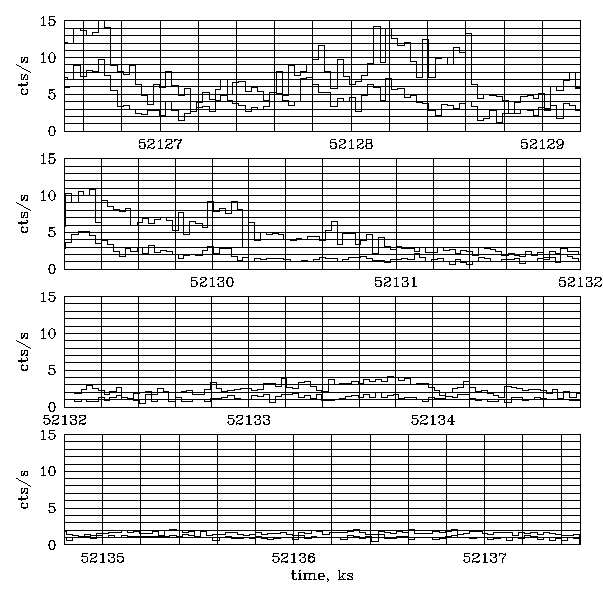 (PS)
(PS)
The figure below shows the background spectra during a moderate flare and during a quiescent interval (OBSID 1226) in the area of chip S3 free of sources. Their exposures are similar (9-10 ks):
 (PS)
(PS)
The next figure shows a difference of the above spectra normalized by their exposures, to give an idea of the spectrum of the additional background component arising during the high rate intervals:
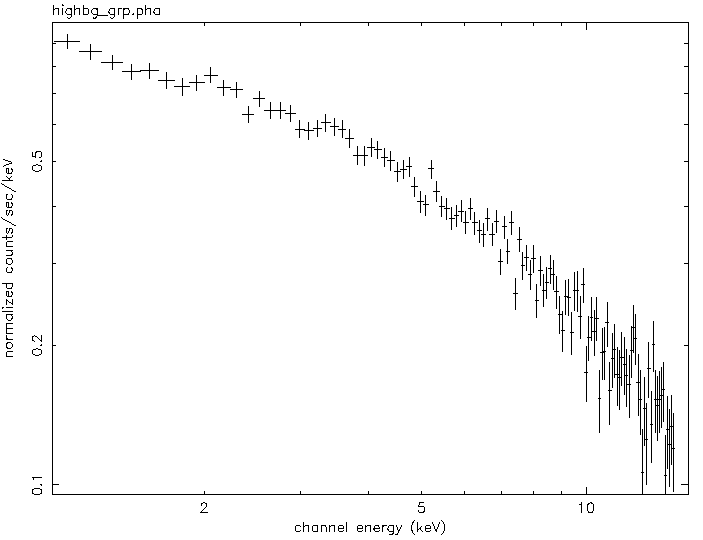 (PS)
(PS)
The telescope effective area drops off much more steeply than this spectrum does. The nature of this component is beyond the scope of this memo.
1.1. Frequency of flares
The figure below shows cumulative probability for the ACIS background rate to be a certain factor above the respective quiescent rate (see below), for an FI chip S2 and a BI chip S3. Only the good grades 1,5,7 and energies 0.3-10 keV are used. Celestial sources were masked out whenever possible, otherwise the target flux was roughly estimated and subtracted, but most included observations were dominated by the background anyway. All observations are made without gratings.
The data were divided into 3 time intervals, August 1999 (about 200 ks in total), September - November 1999 (350 ks for chip S3 and 480 ks for chip S2) and December 1999 - January 2000 (about 400 ks). No effort was made to create a "representative" set of observations, but the observations sample all points of the observatory orbit and are selected more or less randomly. The histograms were made by binning the light curves into 260 s bins (80 times the ACIS readout time) so the Gaussian scatter is rather small.
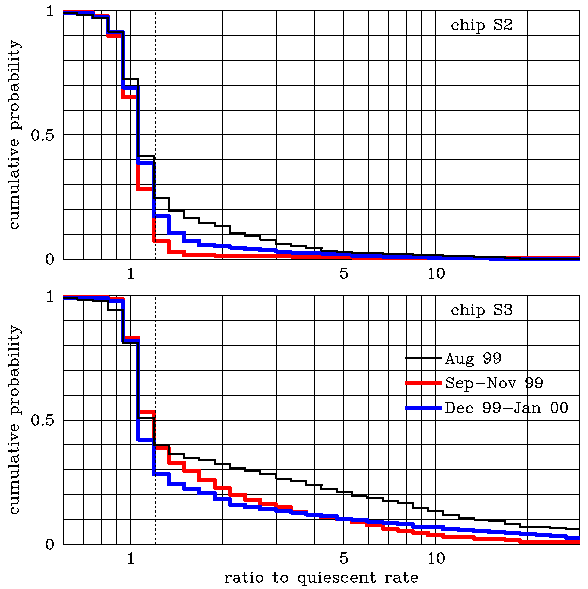 (PS)
(PS)
Other FI and BI chips have similar flare probabilities. From the above histograms, 20-30% of the time the background rate in the BI chips is more than twice the quiescent rate, and 5-15% of the time, it is 10 times the quiescent rate. For the FI chips, 5-15% of the time the background rate is twice the quiescent rate. It appears that the flares have become somewhat less frequent with time since August 1999, although the current tendency is not clear.
1.2. What to do with the flares
Unless the target is a bright point source, it will usually be best to discard the time intervals with flares. Even though this can significantly shorten the exposure, the flares are so bright that it may still increase the signal to noise ratio.
The Calibration team has produced experimental quiescent background event files (see below), created by excluding time intervals with rates outside a factor of 1.2 of the quiescent rate, to keep the background uncertainty below 20%. To use those files, the observation will have to be cleaned similarly. Vertical dotted lines in panels above show this factor of 1.2. For S3, the fraction above this cutoff is between 30-40%, and for S2, it is 10-20%. This is the average fraction of the data that has to be discarded in order to use those background datasets.
2. Quiescent background
During the quiescent periods and after the standard event screening, the background appears to be relatively constant with time (see below). The following tables give observed quiescent background rates in several energy bands, using September 1999 - January 2000 data. The rates are given in cts/s/chip, using only ASCA grades 02346, excluding background flares, bad pixels/columns and celestial sources identifiable by eye. These rates include the CXB component. The energy bands are defined using the 1/20/2000 gain table; this was a tentative table not used in standard data processing, so the rates are only approximate (for more accurate rates at different focal plane temperatures, see this link.)Table 1: ACIS-I in aimpoint:
-------------------------------------------- E,keV I0 I1 I2 I3 S2 S3 -------------------------------------------- 0.3-10 0.31 0.31 0.31 0.29 0.32 0.89 0.5-2 0.07 0.07 0.07 0.07 0.07 0.17 0.5-7 0.19 0.19 0.19 0.18 0.20 0.40 5-10 0.15 0.15 0.15 0.14 0.15 0.51 --------------------------------------------
Table 2: ACIS-S in aimpoint, no gratings:
-------------------------------------------- E,keV S0 S1 S2 S3 S4 S5 -------------------------------------------- 0.3-10 ... 1.41 0.33 0.86 1.04 0.35 0.5-2 ... 0.17 0.07 0.16 0.52 0.10 0.5-7 ... 0.45 0.19 0.38 0.68 0.22 5-10 ... 0.97 0.15 0.50 0.16 0.15 --------------------------------------------
Table 3: ACIS-S in aimpoint, HETG inserted:
-------------------------------------------- E,keV S0 S1 S2 S3 S4 S5 -------------------------------------------- 0.3-10 0.27 1.55 0.38 1.03 1.13 0.33 0.5-2 0.07 0.18 0.10 0.18 0.57 0.08 0.5-7 0.19 0.51 0.26 0.53 0.77 0.21 5-10 0.10 1.08 0.16 0.56 0.16 0.15 --------------------------------------------
As the tables show, the rates for the same chip with either ACIS-I or ACIS-S in aimpoint are close (at least for chips S2 and S3). The rates for different FI chips are very similar, except for S4 that has a defect (a very high background below 2 kev in the form of streaks along the chip x axis; look for J. Houck's destreak for a fix.). The BI chip S3 has a significantly lower high-energy background than the other BI chip, S1 (Mark Bautz says because of the different thickness of the two chips). Finally, the ACIS-S rates with and without HETG are close (but not identical).
The picture for the FI chips is complicated by the large CTI increase during August 1999. It causes some of the good grades to migrate to grade 7 and be rejected by the standard event screening. The BI chips are unaffected by this; however, there is also indication of a genuine slow decrease of the background rate since August 1999, see below.
For completeness, the table below gives approximate total (prior to grade and energy screening) quiescent rates, in cts/s/chip, for the most common ACIS mode with the onboard PHA cut at 3750 ADU (about 15 kev) and standard onboard grade filtering. These rates exclude flare periods but include everything else (the targets had negligible flux in the observations used for this estimate). These rates correspond to observations made in late 1999. The secular decline of this unscreened background is more pronounced than for the cleaned background, see below. These rates may be useful for estimating the telemetry rate.
Table 4: Total rates:
------------------------------------------------------------------ chip I0 I1 I2 I3 S0 S1 S2 S3 S4 S5 ------------------------------------------------------------------ rate 8 8 9 8 11 11 9 10 10 8 ------------------------------------------------------------------The total rates with or without HETG are close to within +-1 cts/s.
2.1. Spectrum
The plots below illustrate contributions of the CXB and cosmic ray components to the quiescent background for an FI chip S2 (top) and a BI chip S3 (bottom), with ACIS-S in aimpoint, after the standard grade and hot pixel cleaning and exclusion of obvious celestial sources. Black shows the data prior to the mirror aft door opening (OBSID 62706) and thus only includes the cosmic ray component, and red shows the total background (a sum of several August 1999 observations after the mirror doors opening).
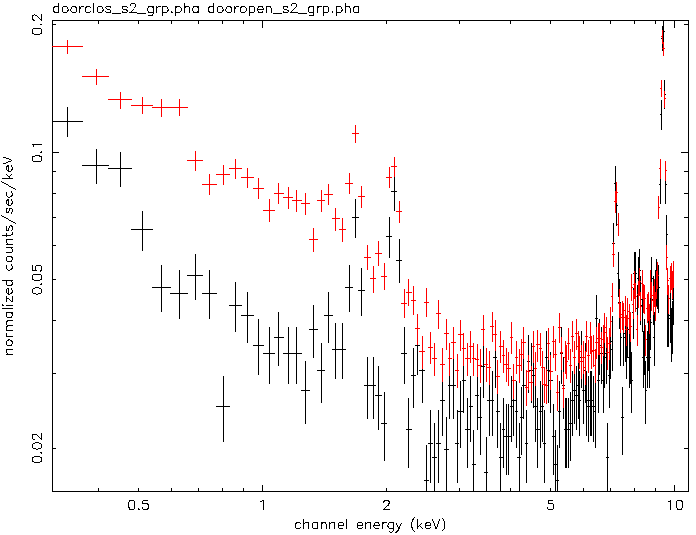 (PS)
(PS)
 (PS)
(PS)
The cosmic ray component dominates above ~5 keV, and it is lower in the FI chips than in the BI chips. A memo by F. Baganoff provides more details on the cosmic ray component.
Finally, the figure below compares the full quiescent background spectra for the BI chip S3 (red) and a representative FI chip I3 (black). They are extracted from regions covering the whole chip, from the Sep 99 - Jan 00 data with ACIS-S and ACIS-I in the aimpoint, respectively, and exclude the standard bad grades, bad pixels and bright celestial sources:
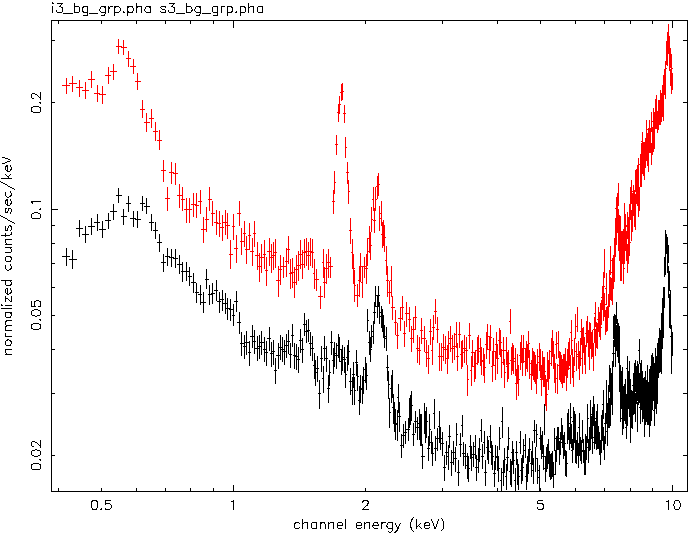 (PS)
(PS)
The above spectra are given here as PHA files that can be used for simulations: I3, S3
2.2. Time dependence of the spectrum
2.2.1. Rates in wide energy bands
The plots below show the quiescent rates in different observations vs. time, for the ACIS-I and ACIS-S3 chips in soft and hard energy bands. Obvious celestial sources are excluded. Filled symbols show "good" observations included in the composite background datasets (see below), while open symbols show several observations not included in those datasets either because of their anomalously high soft background, or too high Galactic absorption, or it was an observation of XRB shadows which would obviously affect our rates, or because the target occupied a significant area of the field (in which case the rates shown were corrected for the excluded geometric area). Vertical dotted lines separate periods with different ACIS focal plane temperature. Horizontal lines show average rates for filled dots during the t=-110C and -120C periods. The energy bands for the -100C and -110C data are defined using a nonstandard 1/20/2000 gain table, while for the -120C data, the appropriate standard gain table is used. Therefore, the comparison of the average values for different periods is not entirely meaningful.
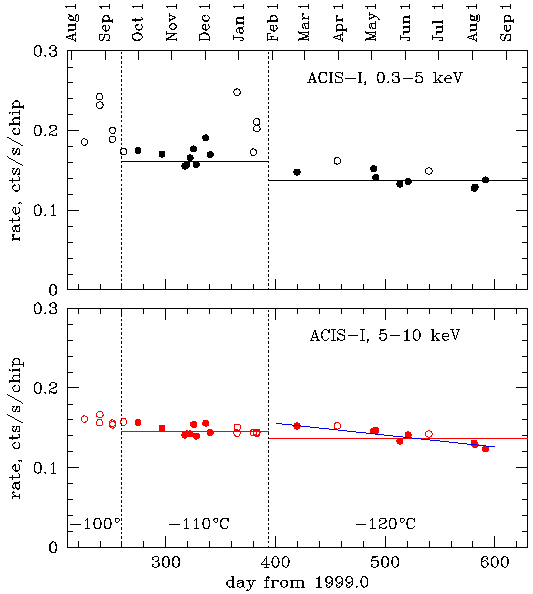 (PS)
(PS)
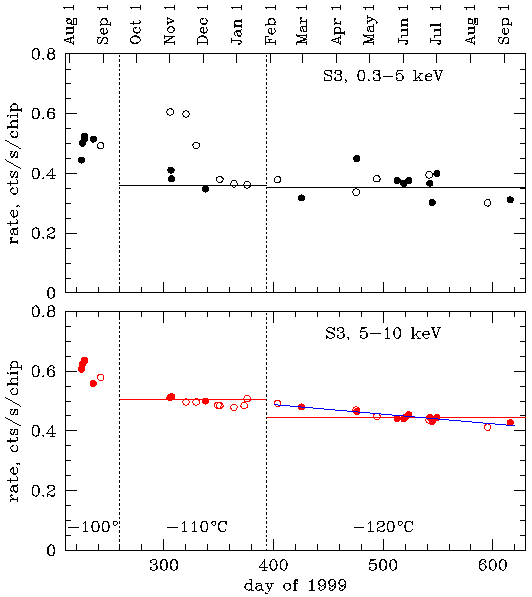 (PS)
(PS)
The plots show that the high-energy rate -- where the background is dominated by its cosmic ray component -- has been remarkably constant (to better than +-10%) since September 1999, after having dropped by up to 30% between August-September (when the appropriate gain tables are applied to the FI chip data, a similar drop is seen). The -120C period is already long enough to notice a hint of a slow decline of both the FI and BI chip background (with some imagination, it is also visible in the -110C period). A blue line in each plot shows the approximate decline; this will be further discussed below. The low-energy rate shows more random variability, obviously due to the celestial diffuse component, and for S3, due to the possible residual uncleaned flares (due to the different quiescent and flare spectral shapes shown in figures above, such residuals would show up in the 3-6 keV interval).
For comparison, the plot below shows how the total quiescent background for S2 and S3 chips (all that ACIS transmits, before any grade or energy filtering on the ground, but after flare screening). It has been steadily declining since launch:
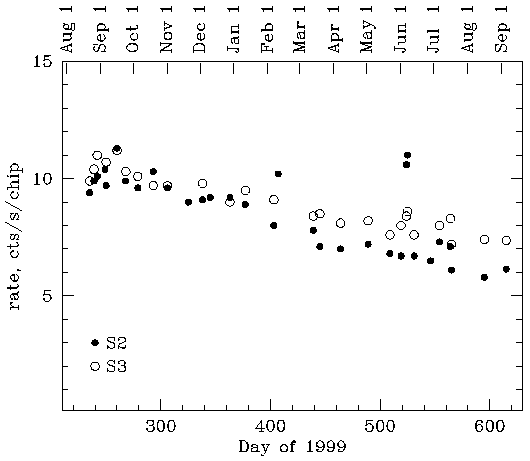 (PS)
(PS)
2.2.2. Spectral variability
Two plots below show the ratio of the spectra from chips S2 and S3 of several ACIS-S observations (cleaned of flares, sources, etc., and normalized by the clean exposure) spanning the Feb-Sep 2000 period, to an average background spectrum for the same period. Black crosses show observations included in that average (and in the quiescent background dataset discussed below), and red crosses show several other obsrevations not included in the average for various reasons, such as the presense of a big object in the field (the object was masked and the rate corrected for the geometric area), too high Galactic NH, or because it was an observation of an XRB shadow. Errors are 1 sigma. Inside each energy interval, the measurements are arranged according to the observation date:
The scatter is significant. However, at energies above 4-5 keV, the scatter is not random -- there is an apparent decrease with the observation date. Indeed, applying a simple energy-independent correction factor taken from the 5-10 keV time dependence figures in the previous section (blue lines; the S2 correction is taken from a similar plot not shown here), we can greatly reduce the scatter at high energies where the background is most important:
The resulting scatter is well within -10% +20% anywhere above 1 keV for S2 and above 5 keV for S3 for observations not expected to have any unusual background components (black crosses). The behavior of ACIS-I background should be similar to S2. A factor of 1.5 deviation in the lowest-energy bin in one observation (obsid 930), present in both S2 and S3 is under investigation. For reference, the renormalization factor applied to the spectra is shown below. The users may apply it to the spectra extracted from the -120C background datasets to reduce the uncertainty of the background modeling.
 (PS)
(PS)
Several S3 observations exhibit a characteristic 20-40% excess in the 3-6 keV interval in the figures above. This must be due to incompletely removed flares -- as mentioned above, due to the different spectral shapes of flares and quiescent background, they should be most visible in this energy interval. All observations have been cleaned of flares by excluding times when the 0.3-10 keV rate was above a factor of 1.2 of the quiescent rate. To improve the accuracy of the background modeling in the 3-6 keV interval, one may need to apply (to both the target data and background data) a more strict cleaning criterion, for example, using the 3-6 keV flux, which would discard more data.
2.3. Spatial structure
The cosmic ray component of the background is spatially nonuniform, as illustrated by the plots below. They show chip x and chip y projections of the 5-10 keV background images for chips S3 and I0 (for the September 1999 -- January 2000 period):
 (PS)
(PS)
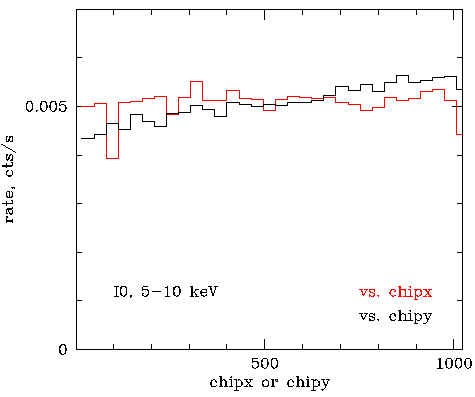 (PS)
(PS)
There are variations by more than 30%. At lower energies, the background is more uniform.
2.3.1. Time dependence of the spatial structure
The spatial structure appears to stay relatively constant within each time period (except for the FI chips during the t=-100C period when the CTI was increasing rapidly). This is illustrated in the plots for the -120C period below. The plots show chip x and y projections of the 5-10 keV images from 4 ACIS-S observations spanning the Feb-Sep 2000 period (red is the earliest and black is the latest), for chips S2 and S3. Each histogram is rescaled by the time-dependent coefficients used for the spectra in the section above, to correct for the overall rate decline:
 (PS)
(PS)
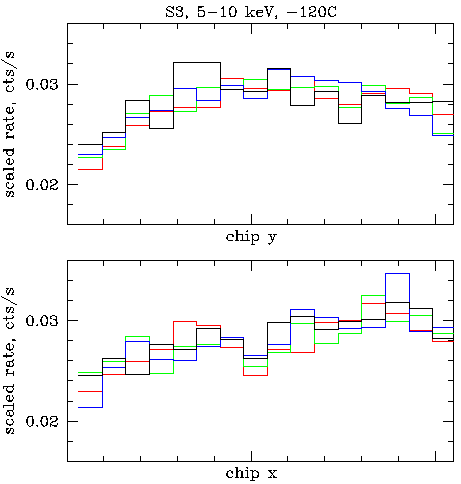 (PS)
(PS)
2.4. How to subtract the background
Spatial nonuniformity of the background precludes its accurate subtraction using source-free sky regions of the same observation. On the other hand, the observed weak dependence of the quiescent background on time, especially at high energies where it is most important for the analysis of celestial sources, lets us use other observations (cleaned of the flares using exactly the same criteria) to model the background. They can be normalized by the ratio of clean exposures, with a possible small correction due to the slow rate decrease as seen above.
A number of source-free observations have been combined to create experimental quiescent background event files (using rather strict flare cleaning criteria) for the three distinct periods in the ACIS life -- the August 1999 (focal plane temperature -100C), September 1999 to January 2000 (t=-110C), and February to September 2000 (t=-120C). These datasets, their detailed description and experimental tools for their use can be found at this link.
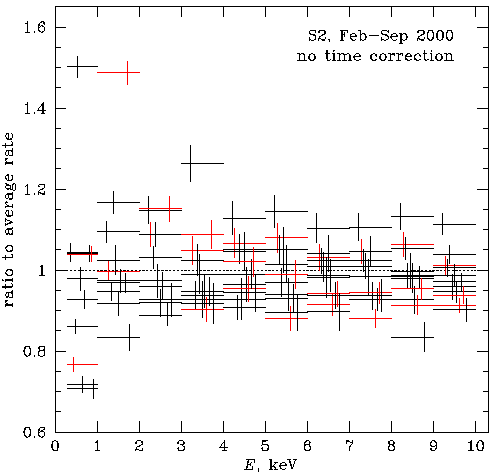 (
( (
(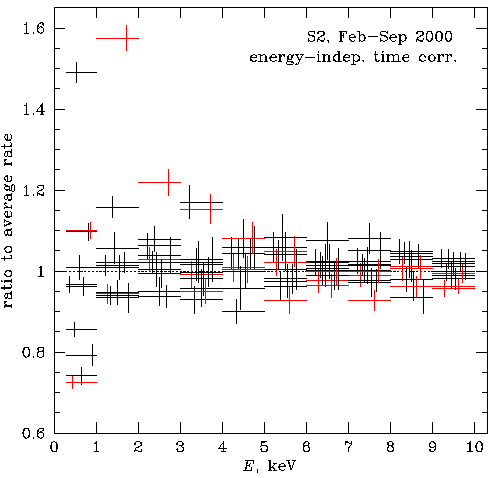 (
( (
(